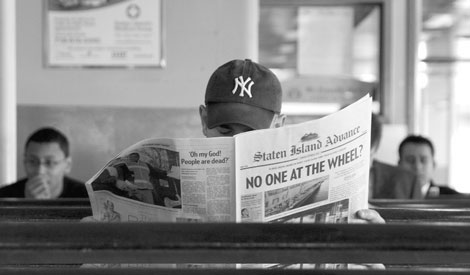By Albert Amateau
Tragedy darkened the hearts of New Yorkers last Thursday when the 3 p.m. Staten Island ferry overshot the slip at St. George in Staten Island and slammed full speed into a service pier killing 10 passengers and injuring about 67 more, leaving some of them maimed and one paralyzed.
The crash occurred at 3:25 p.m. Oct. 16 when the pilot, assistant captain Richard J. Smith, 55, with 18 years in the ferry service, reportedly collapsed over the controls of the ferry, the Andrew J. Barberi, which was carrying about 1,500 passengers, a little more than a quarter of its capacity.
Smith, who fled from the ferry and tried to commit suicide at home by slashing his wrist and firing a pellet gun into his chest, may have passed out because of a high blood pressure condition. He was in serious condition in St. Vincent’s Hospital, Staten Island. The captain, Michael Gansas, 38, according to investigators, was not in the pilothouse with Smith, his usual post on landings, but was reported to have gone to the rear pilothouse early for the return to South Ferry.
And in a second incident that added to Downtowners’ ferry fears four days after the Staten Island tragedy, a fire in the exhaust stack of the SeaStreak ferry, Liberty, at 9:25 a.m. Mon. Oct. 20 off 84th St., Brooklyn, forced the evacuation of eight passengers and four crewmembers. There were no injuries.
The NY Waterway ferry, Millennium, the first boat at the scene, took the eight passengers to Pier 11, near Wall St. The SeaStreak was on its way from South Amboy N.J. to the pier when the fire broke out. The Millennium was bound for Pier 11 from Belford, N.J., when it responded to the call for help. Coast Guard vessels and three other NY Waterway vessels also responded.
Among the dead in the Staten Island disaster were Frank Sullivan, 46, an electrician who was working at the Museum of Jewish Heritage in Battery Park City; Joseph Bagarozza, 35, a clerk at the New York Mercantile Exchange in B.P.C.; Darius Marshall, 25, who was struck by falling debris but survived on Sept. 11, 2001; John T. Healy, of Middletown, N.J., who was riding the ferry to work at the time of the World Trade Center attack; Pio Canini, 52, a carpenter who emigrated from Italy as a child; John Valinski, 40, a carpenter who was engaged to be married; Vincent Ferrante, Jr., 24, a life-long Staten Islander also engaged to be married; Louis Robinson, 50, who was returning home early from his job as a chef in a Midtown hotel because of the flu; Guillermo Paguay, 44, who has a wife and daughter in his native Ecuador and was taking the ill-fated ferry to his job as a waiter in Staten Island, and Carmen Huertas, 42, of Concord, S.I., the only woman killed in the accident.
The scene at the South Ferry slip an hour and a half after the crash in Staten Island was one of confusion with hundreds of Staten Island-bound passengers searching for alternative ways home.
The most reliable sources of information were the red-uniformed Downtown Alliance security guards who told stranded commuters they could take either the N or R trains to 86th St. in Brooklyn for Staten Island buses or Staten Island Express Buses on Water St. Although Express Buses were taking passengers without charging fares, the bus stops were mobbed and passengers had long waits.
Albert@DowntownExpress.com
Reader Services


































